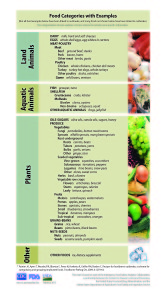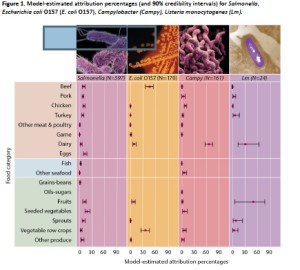It’s an easy story for beleaguered journalists: a belligerent government versus a belligerent union, with both making wild claims about food safety.
Lost in the rhetoric is any concern about the people who eat – pretty much all of us – and the people who barf.
The union representing federal food inspectors says Canada’s food safety system is being pushed beyond its limits.
 Some $35-million and 192 inspectors are on the food safety program’s chopping block over the next two years, according to online documents posted by the Canadian Food Inspection Agency.
Some $35-million and 192 inspectors are on the food safety program’s chopping block over the next two years, according to online documents posted by the Canadian Food Inspection Agency.
The agency has also disbanded a team of inspectors dedicated to protecting consumers from food fraud throughout Metro Vancouver. The Consumer Protection Unit once boasted 11 inspectors, but that number dwindled to four due to attrition.
The federal health ministry referred questions to the CFIA, which responded to the union’s claims with a broad e-mail.
“The statements by the union are false. There have been no cuts to food safety. Canada has one of the safest and healthiest food systems in the world,” it said.
The agency acknowledged there have been recent changes to how it handles the Vancouver area.
Time to change the discussion and the approach to safe food. Time to lose the religion: audits and inspections are never enough.
• Food safety audits and inspections are a key component of the nation’s food safety system and their use will expand in the future, for both domestic and imported foodstuffs., but recent failures can be emotionally, physically and financially devastating to the victims and the businesses involved;
• many outbreaks involve firms that have had their food production systems verified and received acceptable ratings from food safety auditors or government inspectors;
• while inspectors and auditors play an active role in overseeing compliance, the burden for food safety lies primarily with food producers;
• there are lots of limitations with audits and inspections, just like with restaurants inspections, but with an estimated 48 million sick each year in the U.S., the question should be, how best to improve food safety?
• audit reports are only useful if the purchaser or food producer reviews the results, understands the risks addressed by the standards and makes risk-reduction decisions based on the results;
• there appears to be a disconnect between what auditors provide (a snapshot) and what buyers believe they are doing (a full verification or certification of product and process);
• third-party audits are only one performance indicator and need to be supplemented with microbial testing, second-party audits of suppliers and the in-house capacity to meaningfully assess the results of audits and inspections;
• companies who blame the auditor or inspector for outbreaks of foodborne illness should also blame themselves;
• assessing food-handling practices of staff through internal observations, externally-led evaluations, and audit and inspection results can provide indicators of a food safety culture; and,
• the use of audits to help create, improve, and maintain a genuine food safety culture holds the most promise in preventing foodborne illness and safeguarding public health.
Audits and inspections are never enough: A critique to enhance food safety
30.aug.12
Food Control
D.A. Powell, S. Erdozain, C. Dodd, R. Costa, K. Morley, B.J. Chapman
http://www.sciencedirect.com/science/article/pii/S0956713512004409?v=s5
Abstract
Internal and external food safety audits are conducted to assess the safety and quality of food including on-farm production, manufacturing practices, sanitation, and hygiene. Some auditors are direct stakeholders that are employed by food establishments to conduct internal audits, while other auditors may represent the interests of a second-party purchaser or a third-party auditing agency. Some buyers conduct their own audits or additional testing, while some buyers trust the results of third-party audits or inspections. Third-party auditors, however, use various food safety audit standards and most do not have a vested interest in the products being sold. Audits are conducted under a proprietary standard, while food safety inspections are generally conducted within a legal framework. There have been many foodborne illness outbreaks linked to food processors that have passed third-party audits and inspections, raising questions about the utility of both. Supporters argue third-party audits are a way to ensure food safety in an era of dwindling economic resources. Critics contend that while external audits and inspections can be a valuable tool to help ensure safe food, such activities represent only a snapshot in time. This paper identifies limitations of food safety inspections and audits and provides recommendations for strengthening the system, based on developing a strong food safety culture, including risk-based verification steps, throughout the food safety system.





.jpg) safety advocates were also bemoaning yet another missed Food Safety Modernization Act (FSMA) deadline.
safety advocates were also bemoaning yet another missed Food Safety Modernization Act (FSMA) deadline..jpg) themselves.
themselves..jpg) Commodity Specific Guidance for Melons and we are 100 percent committed to continuing work to improve the existing guidance and to funding new priority research projects that will lead to a safer product for consumers.
Commodity Specific Guidance for Melons and we are 100 percent committed to continuing work to improve the existing guidance and to funding new priority research projects that will lead to a safer product for consumers.
 their Saturday morning lattes and eggs Benedict, but offers nothing for the over-easy crowd.
their Saturday morning lattes and eggs Benedict, but offers nothing for the over-easy crowd..jpg) requirements created headaches for producers selling nationwide.
requirements created headaches for producers selling nationwide. Internet or even personal phones to see how the eggs were raised and testing data. The best producers and processors will go far beyond the lowest common denominator of government and should be rewarded in the marketplace.
Internet or even personal phones to see how the eggs were raised and testing data. The best producers and processors will go far beyond the lowest common denominator of government and should be rewarded in the marketplace..jpg) United Egg Producers. The trade group is developing safety standards for the industry that would go beyond federal regulations.
United Egg Producers. The trade group is developing safety standards for the industry that would go beyond federal regulations.
 programs.
programs.(2).jpg) Author
Author